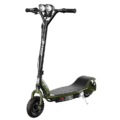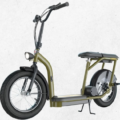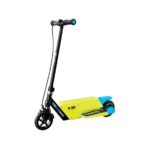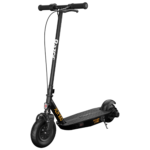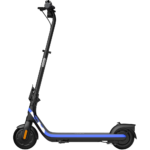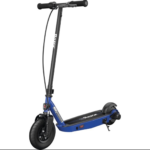- Home
- Scooters
- Electric Scooters
- Razor Power Core E90 Lightshow
Razor Power Core E90 Lightshow
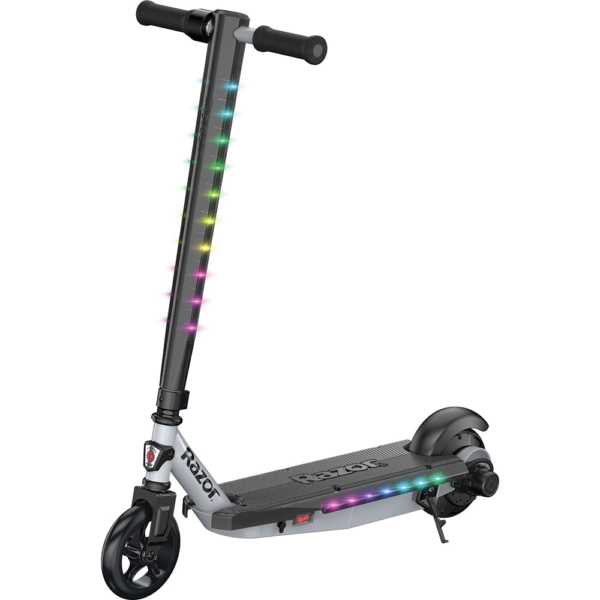

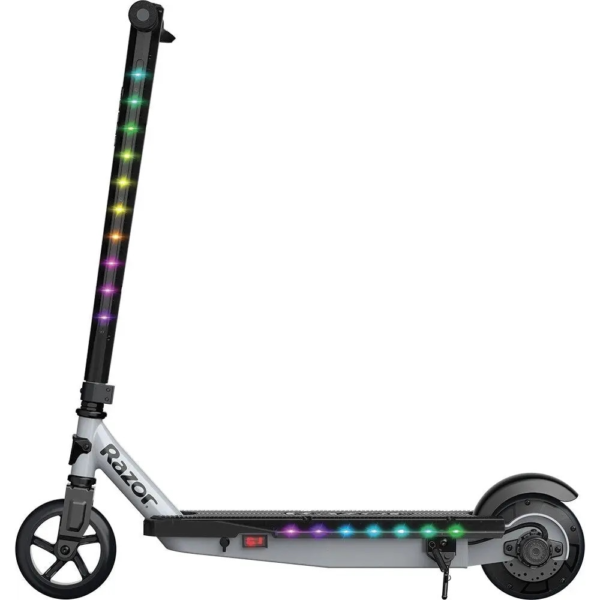

- Battery Range: 10 mi (16 km)
- Top Speed: 10 mph (16 km/h)
- Motor Power: 90 W nominal
- Weight Capacity: 120 lb (54 kg)
- Charging Time: ~4–5 h
- Scooter Weight: 22.0 lb (10.0 kg)
PROS
- LED lightshow boosts visibility
- Kid-friendly 10 mph cap
- Low-upkeep Power Core hub
- Solid tires resist flats
- Light and easy to carry
CONS
- Not for adults
- Shorter range
- No suspension
- Lower weight capacity
Table of contents
- What Is the Razor Power Core E90 Lightshow?
- How the Razor Power Core E90 Lightshow Works
- Key Specifications
- Design & Build Quality
- Performance Fundamentals
- Battery, Range & Efficiency
- Ride Quality & Comfort
- Braking & Safety Features
- Portability & Daily Usability
- Maintenance & Care
- Weather & Seasonal Considerations
- Razor Power Core E90 Lightshow vs Alternatives
- Who the Razor Power Core E90 Lightshow Is (and Isn’t) For
- FAQs
- Glossary
- Final Thoughts
A light-up scooter can turn ordinary rides into a nightly show, and the Razor Power Core E90 Lightshow does exactly that for young riders. It blends a modest, kid-friendly hub motor with bright LEDs along the deck and steering tube. Consequently, beginners get a simple, low-maintenance first e-scooter that prioritizes fun, visibility, and predictable handling. This overview explains how it works, what to expect on real streets and sidewalks, and how to keep it running smoothly for seasons of riding.
What Is the Razor Power Core E90 Lightshow?
At its core, the Power Core E90 Lightshow is a youth-focused electric kick scooter with a hub motor in the rear wheel and a sealed lead-acid battery inside the deck. It’s designed for kids stepping up from a manual kick scooter yet not ready for adult commuter speeds. Moreover, the “Lightshow” name refers to integrated LED strips that glow and pulse while rolling, adding flair and improving side visibility at dusk. Additionally, parents often compare it with the Razor Power Core E90 when deciding between variants.
Because the motor is hub-mounted, there’s no chain to tension and no external belt to collect debris. As a result, maintenance stays simple. The top speed is modest and the throttle is either on or off, which helps new riders learn smooth starts. Instead of a hand brake, the scooter uses a foot-operated rear fender brake that presses on the rear wheel. Therefore, the controls are intuitive and easy to master.
How the Razor Power Core E90 Lightshow Works
Electric scooters share the same basic building blocks: a motor, a controller, a battery, and rider controls. Here is how those pieces come together on this model.
Motor (rear hub, ~entry-level wattage).
The motor is built into the rear wheel. After a small push-off, a tap on the throttle tells the controller to feed power to the hub, and the scooter accelerates to a limited top speed. Because the motor sits in the wheel, there’s no chain drive to oil or adjust. Consequently, energy flows directly to the tire contact patch, which keeps things quiet and efficient.
Controller (the scooter’s “brain”).
A compact electronic controller sits inside the deck. It interprets throttle input and battery state, then pulses power to the motor. On this model the logic is straightforward: kick-to-start, then an on/off throttle map that limits peak speed. This simplicity keeps costs and complexity down while delivering predictable behavior for new riders.
Battery (sealed lead-acid, 12V class).
Power comes from a sealed lead-acid pack housed under the deck. Although lead-acid is heavier than lithium-ion, it’s robust and budget-friendly. It’s well suited for a youth scooter with a modest motor and a capped top speed. The brand rates this platform for up to about 80 minutes of continuous ride time under ideal conditions. Even so, real numbers vary, and we’ll cover why shortly.
Throttle (simple push-button).
Many kids’ scooters in this family use a thumb or push-button throttle. Press to go; release to coast. Because the control is on/off, riders learn to manage speed with short presses rather than feathering a lever. That approach also reduces moving parts.
Brakes (rear fender, mechanical).
A sturdy fender over the back wheel doubles as a friction brake. Step on it to slow down. Since the motor sits in the rear wheel, there’s no separate disc brake. Instead, slowing relies on friction at the tire plus natural motor drag when the throttle is released. Consequently, stopping feels simple and predictable at neighborhood speeds.
Think of it like this: the motor is your helper; the foot fender is your stopper; the controller is a traffic cop that keeps speeds sensible; and the battery is the fuel tank. Together, they make the ride easy to understand.
Key Specifications
Note: Values below reflect the typical configuration for this model family. Exact figures can vary by market and production run.
General
| Item | Details |
|---|---|
| Intended rider | Youth / beginner |
| Drive | Rear hub motor (no chain) |
| Top speed | Capped for kids (around neighborhood speed) |
| Ride time | Manufacturer-rated up to ~80 minutes (continuous) |
| Wheel type | Solid polymer (airless) |
| Folding | Non-folding, fixed stem |
| Kickstand | Yes, side-mount |
Performance & Power
| Item | Details |
|---|---|
| Motor type | Brushless rear hub |
| Power feel | Gentle launch, capped peak speed |
| Hill behavior | Handles mild grades; slows on steeper hills |
| Acceleration | Smooth, on/off throttle response |
| Drive noise | Quiet hum, no chain whir |
Battery, Charging & Electrical
| Item | Details |
|---|---|
| Chemistry | Sealed lead-acid (12V class) |
| Charger | Plug-in wall charger with status light |
| Charge time | Typically several hours from empty (plan ahead) |
| Lights | Integrated deck and tube LEDs (“Lightshow”) |
| Battery access | Enclosed under deck; serviceable with tools |
Build & Dimensions (include folded dimensions)
| Item | Details |
|---|---|
| Frame | Steel with polymer deck cladding |
| Deck | Low, wide enough for youth stance; grippy surface |
| Stem | Fixed height, scaled for kids |
| Weight | In the low-20-pound range |
| Assembled size | Compact, kid-sized footprint |
| Folded dimensions | N/A (non-folding) |
Safety & Control
| Item | Details |
|---|---|
| Primary brake | Rear fender, foot-operated |
| Secondary slowing | Motor drag when throttle is released |
| Speed limiting | Yes, electronic cap via controller |
| Reflectivity | LEDs improve side visibility; add reflectors if needed |
| Water resistance | Not intended for wet riding; avoid puddles |
Features & Extras (include Cruise Control if relevant)
| Item | Details |
|---|---|
| LED effects | Deck and tube light patterns while rolling |
| Kick-to-start | Yes, for safer launches |
| Cruise Control | Not available |
| Bell/horn | Not typically included |
| App connectivity | None required |
Warranty & Compliance
| Item | Details |
|---|---|
| Warranty | Limited manufacturer coverage (varies by region) |
| Compliance | Built to consumer ride-on standards; check local rules |
Design & Build Quality
The overall build emphasizes durability and simplicity. The frame uses steel tubing for strength, while the deck is protected with tough polymer shells that handle scuffs from shoes and curb bumps. Because the scooter doesn’t fold, the stem is a single, solid piece. That reduces play at the clamp and keeps the cockpit tidy. Young riders benefit from the fixed geometry, which prevents misalignment during rough handling.
The deck height is low for easy step-on starts. Additionally, it helps balance by keeping the rider’s center of gravity closer to the ground. The deck’s top surface offers traction with molded texture, so sneakers grip even when dusty. Meanwhile, the rear fender is thick and reinforced. It sees a lot of action, so rugged construction matters.
Up front, the handlebar grips are soft, slightly tacky, and sized for smaller hands. The throttle button integrates neatly at the right grip, and the power switch sits low, out of the way. Wiring for the LED strips is routed inside enclosures and strain-relieved at entry points. Consequently, the lighting avoids snag points and survives day-to-day knocks.
You’ll also notice the rear hub wheel looks beefier than a typical kick scooter wheel. That’s the motor housing. Because the motor is sealed, dirt and splashes are less of a problem than with open chains. Still, this is not a water scooter, and riders should avoid puddles. Overall, fit-and-finish is kid-friendly: rounded edges, a clean cable layout, and colors that pop when the LEDs fire up.
Performance Fundamentals
Acceleration feel.
Starts are smooth once the rider gives a small push and taps the throttle. The on/off throttle encourages short bursts of power to adjust speed. There’s no sudden surge, and peak speed arrives gradually. Therefore, new riders gain confidence quickly.
Cruising stability.
At neighborhood pace, the scooter tracks straight and resists wobble. The fixed stem helps, and the short wheelbase keeps turning quick. However, solid polymer wheels transmit bumps. On smooth sidewalks and driveways, the ride feels planted. On cracked pavement, the scooter chatter increases, which is normal for airless tires.
Hill-climb behavior.
On gentle slopes around 7%, the motor keeps rolling with a noticeable drop in speed. On steeper grades near 10%, many riders will need to help with a kick or two. That’s not a flaw; it reflects the platform’s safety-minded power and the realities of lead-acid voltage sag under load. Consequently, riders quickly learn to carry a little momentum into short hills and to step off and walk if needed.
Top-speed manners.
Because the controller caps speed, there’s no hidden “extra” beyond the limiter. This is intentional. Predictable top speed is a safety feature on youth scooters, and it keeps stopping distances short. As a result, the scooter behaves calmly even when excitement rises.
Battery, Range & Efficiency
Lead-acid packs like the one inside this scooter deliver stable, budget-friendly power. They’re heavier than lithium-ion and don’t like deep discharges. Nevertheless, they perform reliably when you treat them well.
Rated vs real-world range.
The brand quotes up to around 80 minutes of continuous use. In practice, factors like rider weight, temperature, hill count, pavement smoothness, and stop-and-go riding push that number up or down. On a warm day with a light rider and flat ground, long continuous runs are realistic. Conversely, on hilly routes with frequent stops or in cold weather, ride time drops sooner. Think of the rating as “best case” rather than a daily guarantee.
Temperature effects.
Lead-acid chemistry loses punch as temperatures fall. Below about 50°F (10°C), expect shorter rides. In high heat, chemistry wakes up but ages faster if left fully charged for weeks. Therefore, moderate temperatures are ideal.
Charging best practices.
Top off after every ride. Avoid leaving the pack fully discharged overnight. Give the scooter a few minutes to cool before charging after a long session, and avoid storing it empty. If the scooter will sit for weeks, charge it to full, disconnect the charger, then top up monthly. Taken together, those habits extend pack life and help preserve ride time.
Efficiency tips.
Coach kids to use pulses of throttle and coast between taps. Smooth concrete yields longer rides than rough asphalt. Likewise, gentle turns and gradual starts reduce current spikes, which helps the battery go the distance.
Ride Quality & Comfort
This is a rigid scooter with solid wheels and no suspension. That combination is low-maintenance and puncture-proof, yet it transmits surface texture to the rider.
Tires.
Solid polymer wheels roll best on smooth surfaces. They don’t go flat, and they keep steering precise. On rough aggregate, the deck vibrates more. Accordingly, encouraging riders to seek smoother paths pays off with comfort and longer ride time.
Ergonomics.
The handlebar height matches youth proportions, and the deck is low and stable. Young riders can place both feet side by side or ride staggered. The rear fender is easy to find with the back foot when braking, and there’s enough deck length for small stance adjustments during longer rides. Consequently, the overall stance feels natural and secure.
Stem flex.
Because there’s no folding joint, stem flex is minimal for a scooter in this category. That contributes to calm steering. If you hear creaks, it’s usually from the deck plastics settling, not from frame flex. Even so, a quick fastener check often resolves new noises.
Overall, comfort comes from the scooter’s scale and rider posture rather than suspension components. Keep rides to friendly surfaces and distances, and the experience stays smooth.
Braking & Safety Features
Braking system.
The rear fender is the primary brake. Press down to apply friction to the wheel, and the scooter scrubs speed quickly at neighborhood pace. Riders should practice progressive pressure rather than stomping the fender. Practice also teaches distance judgment. Because the throttle is on/off, releasing it early helps the scooter settle before the foot brake finishes the stop. Consequently, stopping becomes smooth and repeatable.
Lighting and visibility.
The “Lightshow” LEDs add lateral visibility, which is helpful at dusk. They are not forward headlights, so riders should still avoid dimly lit routes. For added visibility, reflective stickers on the helmet or backpack further improve conspicuity.
Wet riding.
This scooter is not built for rain. Solid wheels lose grip on wet paint lines and leaves, and the electronics aren’t rated for splashes. If the ground is damp, save the ride for later. In short, dry conditions are best.
Protective gear.
A properly sized helmet is non-negotiable. Knee and elbow pads are wise for early sessions. Close-toed shoes with grippy soles make a real difference during braking drills. Ultimately, good gear and patient practice build safe habits.
Portability & Daily Usability
Weight and carrying.
The scooter’s mass sits in the deck, which makes it feel heavier than a manual kick scooter when carried by the stem. Adults will find it manageable for short lifts into a trunk or up a few steps. However, kids may need help lifting it over obstacles.
Fold mechanism.
There isn’t one. The fixed stem is simple and tough, with nothing to latch or misalign. Storage, therefore, happens as a full-size unit. A garage corner, mudroom, or covered porch works well.
Storage and charging routine.
Choose a dry spot near an outlet, and leave clearance around the deck so the charger’s brick can vent. Coil the cord neatly to avoid trip hazards. After riding, switch the scooter off, let it cool briefly, then plug in until the charger indicates full. Then, disconnect the charger to avoid unnecessary trickle time.
Security habits.
Because the scooter lacks a built-in lock point and is small enough to carry away, it shouldn’t be left unattended outside. Instead, bring it indoors or keep it within sight.
Daily rhythm.
A practical rhythm looks like this: a weekend session in the afternoon, a short top-off charge before dinner, and the charger disconnected by bedtime. Repeating this routine keeps both kids and batteries happy.
Maintenance & Care
Simplicity is the point here. Still, a little care prevents small issues from becoming big ones.
After every few rides
- Wipe down the deck and wheels with a damp cloth; avoid soaking.
- Check that the power switch clicks positively.
- Inspect the LED strips for damage or loose sections.
Weekly
- Ensure axle nuts and visible fasteners are snug.
- Spin each wheel by hand to confirm it turns freely and tracks straight.
- Test the rear fender brake on a gentle slope at walking speed.
Monthly
- Charge to full even if the scooter hasn’t been used.
- Check the charger cable for nicks or loose plugs.
- Listen for new rattles; tighten plastics carefully if needed.
Seasonally
- Evaluate the battery’s stamina. If ride time has dropped sharply despite good habits, the pack may be nearing replacement age.
- Inspect tires for flat spots from hard braking. Rotate wear by swapping front and rear only if the design and hardware allow and instructions support it; if not, replace the worn wheel as a unit.
- Store the scooter clean, dry, and fully charged if it will sit for a month or more.
Because this model has no app or firmware, you can skip digital updates entirely. That’s one less thing to track. Nevertheless, keeping a simple notebook of ride time and charge behavior helps you notice changes early.
Weather & Seasonal Considerations
Rain.
Avoid it. Solid tires lose traction, and water can work its way into switches and connectors. If you get surprised by a drizzle, head home slowly and dry the scooter thoroughly. Do not hose it down. Instead, use a soft cloth and patience.
Cold.
Battery output dips in the cold, so ride time shrinks. Plan shorter sessions and a warm-up spin to get parts moving. Charge indoors at room temperature for best results. Additionally, store the scooter away from freezing drafts.
Heat.
Lead-acid batteries don’t love baking in a hot garage all day while plugged in. After a full charge, disconnect the charger. Then, store the scooter out of direct sun and away from heaters. These habits reduce needless aging.
Dust and debris.
Dusty paths are fine, but pebbles can pit the rear tire during hard fender braking. Teach riders to brake earlier and lighter, especially on rough surfaces. Likewise, sweeping the garage area keeps grit off the deck and wheels.
With a few seasonal tweaks, the scooter remains a reliable neighborhood cruiser.
Razor Power Core E90 Lightshow vs Alternatives
When you compare this model to other choices, it helps to group them by purpose.
Versus manual kick scooters.
The Lightshow cruises longer with less effort and adds a motorized grin factor. However, it’s heavier to carry and cannot be ridden in skateparks. For learning balance and sidewalk etiquette, both options work; the motor simply enlarges the neighborhood.
Versus other youth e-scooters.
Some youth models add a hand brake, a twist throttle, or small suspension components. Those features can be nice but also add complexity. By contrast, the Power Core E90 Lightshow leans into simplicity and lighting appeal. If your child values sparkle and straightforward controls, it excels.
Versus commuter e-scooters.
Adult commuters expect folding stems, pneumatic tires, and higher speeds. Those scooters weigh more, cost more, and demand more attention to tire pressure and brake tuning. For a child’s first e-scooter, the Lightshow’s capped speed and uncomplicated design are strengths, not limitations. Consequently, it suits family neighborhoods far better than busy urban routes.
Versus off-road or performance models.
Bigger motors and knobby tires handle trails and steep hills. They also carry real risks for young riders. The Lightshow is built for sidewalks, driveways, and smooth paths. On that terrain, it shines. Therefore, save performance platforms for experienced riders.
In short, this model excels when you prioritize predictable speed, low maintenance, and kid-approved lighting, not long-distance commuting or adult-level power.
Who the Razor Power Core E90 Lightshow Is (and Isn’t) For
Great for:
- Kids graduating from manual scooters who want steadier cruising.
- Families seeking a simple, durable first e-scooter with built-in visibility.
- Neighborhood rides on smooth sidewalks, driveways, and park paths.
- Parents who prefer limited top speed and minimal maintenance.
Not ideal for:
- Long school commutes with hills and busy crossings.
- Riders who need a foldable scooter for crowded public transit.
- Wet climates where rain is frequent and unavoidable.
- Teens or adults who want higher speeds or long-range batteries.
If you keep expectations aligned with its mission, the Lightshow becomes a dependable, confidence-building first step into powered rolling. Ultimately, it’s about safe fun rather than raw speed.
FAQs
1) How fast does it go, and can you change the limit?
The scooter’s controller caps speed for safety. It’s not intended to be modified. Instead, riders should learn within that limit rather than trying to override it.
2) How long does the battery last per charge?
Under friendly conditions, continuous ride time can approach the brand’s rating. Cold weather, hills, and frequent stops shorten that time. Therefore, charging after each ride helps.
3) Is the Razor Power Core E90 Lightshow good for hills?
It’s comfortable on gentle grades. On steeper hills, the scooter slows, and a few push kicks help. For sustained climbs, walking may be the smarter choice.
4) What does the maintenance look like?
Keep it clean and dry, check a few fasteners weekly, and charge properly. There’s no chain to oil and no tire pressure to manage. Over time, the battery and wheels are the main wear items.
5) Can kids ride it in the rain?
No. It’s not designed for wet riding. Water reduces traction and can harm electronics. In short, save rides for dry days.
6) Where can I get a simple Razor Power Core E90 Lightshow overview for parents?
You’re reading one. This guide covers how it works, what to expect, and how to care for it in plain language.
7) Does it have cruise control or an app?
No. The throttle is on/off, and there’s no app to manage. That keeps the scooter simple and reduces distractions while riding.
Glossary
Ah (amp-hours) — A measure of battery capacity. Higher Ah generally means more stored energy.
Wh (watt-hours) — Battery energy (voltage × amp-hours). Useful for comparing packs.
Controller — The electronics that interpret throttle and battery input to power the motor.
Hub motor — A motor built into the wheel hub. It’s quiet and low-maintenance.
Kick-to-start — The scooter requires a small push before the motor engages. This prevents accidental launches.
On/off throttle — A simple control that provides power when pressed and coasts when released.
Lead-acid battery — A robust, budget-friendly chemistry used here; heavier than lithium-ion.
Voltage sag — Temporary drop in available voltage under load, especially noticeable on hills.
Regen (regenerative braking) — Using the motor to slow and recover energy. This model relies on a foot brake instead.
Fender brake — A rear fender that presses on the wheel to slow the scooter.
Stem flex — Side-to-side bending in the steering column. Minimal here because there’s no folding joint.
IP rating — A standardized water/dust protection score. This scooter isn’t rated for wet riding.
Top-off charge — A shorter post-ride charge to return the battery to full.
Duty cycle — The ratio of ride time to rest time. Longer rests between rides can extend battery life.
Service interval — A regular schedule for checks (fasteners, wheels, brake), which keeps the scooter safe.
Final Thoughts
The Razor Power Core E90 Lightshow offers a friendly blend of sparkle, safety, and simplicity. It doesn’t promise adult-level power or folding portability. Instead, it delivers predictable pace, low-maintenance hardware, and an LED glow that keeps kids excited to roll. With dry-weather riding, sensible charging habits, and quick weekly checks, it becomes a dependable companion for neighborhood adventures. Ultimately, that combination makes it an easy recommendation for a child’s first e-scooter.
Specifications
General
| Model The Model specifies the exact version or name of the scooter. It helps identify its unique design, features, and specifications within the manufacturer’s product line. Knowing the model makes it easier to compare options, find compatible accessories, or look up support information. | Power Core E90 Lightshow |
| Brand The Brand identifies the manufacturer or company that designs and produces the scooter. A trusted brand is a sign of quality, reliability, and good customer support. Well-known brands often have higher standards for safety, performance, and after-sales service, giving you more confidence in your purchase. | Razor |
| Release Date The Release Date indicates when the scooter model was officially launched on the market. This helps you know how current the design, technology, and features are. A newer release date often means updated components, improved performance, and the latest safety or smart features. | 17 November 2025 |
| Recommended Age Recommended Age indicates the minimum age range that the scooter is designed for, based on safety, size, and ease of use. Following the recommended age helps ensure that riders can handle the scooter’s speed, weight, and controls comfortably and safely. Always check local laws and use protective gear, especially for younger riders. | Recommended 8+ |
Performance & Power
| Motor Power (Wattage) What it means: The motor power, measured in watts (W), shows how strong the scooter’s electric motor is. Why it matters: Higher wattage usually means better acceleration, more torque, and improved performance on hills or rough terrain. For example, a 250W motor is good for flat city roads and light riders, while a 500W or 1000W motor provides more power for faster speeds or climbing steep inclines. | 90 W nominal (Power Core) |
| Top Speed The Top Speed indicates the maximum speed that the scooter can reach under optimal conditions. It’s usually measured on level ground with a fully charged battery and an average rider weight. A higher top speed allows you to travel longer distances faster, but always ensure you ride within legal speed limits and your personal comfort zone for safety. | 10 mph (16 km/h) |
| Battery Capacity Battery Capacity refers to the total amount of energy the scooter’s battery can store, usually measured in ampere-hours (Ah) or watt-hours (Wh). A higher battery capacity means you can ride longer distances on a single charge, reducing the need for frequent recharging. Keep in mind that actual range can vary depending on rider weight, terrain, speed, and weather conditions. | 12–24 V 5 Ah class |
| Estimated Range per Charge The Estimated Range per Charge indicates the average distance the scooter can travel on a single full battery charge. This range is calculated under optimal conditions, such as flat terrain, moderate speed, and average rider weight. Real-world range may vary depending on riding style, terrain, weather, and load. A longer range means fewer recharges and greater freedom for longer trips. | Up to 10 mi (16 km) |
| Hill Climb Ability Hill Climb Ability describes the maximum incline or slope that the scooter can handle while maintaining stable performance. It’s typically expressed as a percentage or in degrees. A higher hill climb rating means the scooter can tackle steeper hills without losing too much speed or power. Actual climbing performance may vary based on rider weight, battery charge, and terrain conditions. | Gentle slopes |
| Drive System The Drive System refers to how power from the motor is delivered to the wheels. Electric scooters typically use either a hub motor (directly integrated into the wheel) or a chain/belt drive system. A high-quality drive system ensures smooth acceleration, efficient power transfer, and low maintenance. The choice of drive system affects performance, noise level, and overall ride experience. | Rear hub motor (RWD) |
Charging & Electrical
| Charging Time Charging Time indicates how long it takes to fully recharge the scooter’s battery from empty to 100% using the standard charger provided. Faster charging means less downtime and more time on the road. Actual charging time may vary slightly depending on battery capacity, charger output, and environmental conditions. | Approx. 4–5 hours |
| Battery Type Battery Type refers to the specific technology used in the scooter’s battery, which affects performance, lifespan, weight, and charging time. Most modern electric scooters use high-quality lithium-ion (Li-ion) batteries because they offer a good balance of energy density, durability, and low maintenance. A reliable battery type ensures consistent power delivery and longer riding ranges. | Li-ion with basic BMS |
| Removable Battery A Removable Battery means the battery pack can be easily detached from the scooter for convenient charging and replacement. This feature allows you to charge the battery separately, swap it with a spare for extended range, or securely store it indoors in extreme weather. Removable batteries add flexibility and make it easier to keep your scooter powered up wherever you are. | No external fast charge |
| Regenerative Braking Regenerative Braking is an energy-saving feature that converts some of the energy normally lost during braking back into battery power. When you slow down or brake, the motor works in reverse to generate electricity, which helps extend the scooter’s range and improves overall efficiency. This system also reduces wear on traditional brake components, leading to lower maintenance over time. | Electronic front assist |
| Lighting Lighting refers to the built-in front and rear lights that enhance visibility and safety when riding in low-light conditions or at night. Good lighting helps you see the road ahead and ensures that other road users can see you. Many scooters include LED headlights, taillights, and sometimes brake lights or side reflectors for added safety and compliance with local traffic regulations. | LED lighting + reflectors |
Build & Dimensions
| Scooter Weight Scooter Weight refers to the total weight of the scooter when fully assembled, including the battery. This affects how easy it is to carry, lift, and store the scooter when not in use. A lighter scooter is more portable and convenient for commuting, especially if you need to carry it upstairs or onto public transport. Keep in mind that a sturdy frame and quality components may add to the weight but also contribute to better durability and ride stability. | 22.0 lb (10.0 kg) |
| Maximum Rider Weight Maximum Rider Weight indicates the highest rider weight that the scooter is designed to safely support while maintaining optimal performance and stability. Staying within this limit helps ensure reliable acceleration, braking, and climbing ability, and it protects the frame, suspension, and motor from excessive strain. Exceeding the recommended limit may reduce performance and increase wear on components. | 120 lb (54 kg) |
| Deck Size Deck Size refers to the dimensions of the scooter’s standing platform. A wider and longer deck provides more foot space, allowing you to stand comfortably and adjust your stance while riding. A well-sized deck improves balance and stability, especially on longer rides or at higher speeds. Compact decks, on the other hand, help keep the scooter lightweight and portable. | Low deck; narrow stance |
| Handlebar Height Handlebar Height refers to the distance from the deck to the handlebars, which affects your riding posture and comfort. An appropriate handlebar height helps you maintain good balance, reduces strain on your back and arms, and makes steering more comfortable. Some scooters have adjustable handlebars to fit riders of different heights, while others have a fixed height for a streamlined design. | Kid-height bars |
| Folding Mechanism The Folding Mechanism describes how easily and securely the scooter can be folded for carrying and storage. A well-designed folding system lets you quickly collapse the scooter into a compact size, making it convenient to transport on public transit, store under a desk, or fit into a car trunk. Look for sturdy latches and safety locks to ensure the scooter stays firmly in place when folded or unfolded. | Simple folding latch |
| Dimensions Folded Dimensions indicate the size of the scooter when it’s fully folded. This measurement shows how much space the scooter will take up when stored or carried, making it easier to check if it will fit in your car trunk, under a desk, or in a closet. Compact folded dimensions are ideal for commuters who need to bring their scooter on public transport or store it in tight spaces. | 36.0 × 14.0 × 15.0 in (folded) |
| Material Material refers to the primary construction materials used for the scooter’s frame and key components. High-quality materials like aircraft-grade aluminum, reinforced steel, or durable composites provide strength, stability, and a lighter overall weight. A sturdy material ensures the scooter can handle daily wear and tear while maintaining safety and performance. | Aluminum/steel mix |
Safety & Control
| Brake Type(s) Brake Type(s) describe the braking systems the scooter uses to help you slow down or stop safely. Common brake types include mechanical brakes (like drum or disc brakes), electronic brakes, and foot brakes. Many scooters combine multiple braking systems for added safety and shorter stopping distances. The type and quality of brakes affect your control, especially when riding at higher speeds or on slopes. | Front electronic + rear foot |
| Suspension Suspension refers to the system that absorbs shocks and vibrations while riding, providing a smoother and more comfortable ride over uneven or rough surfaces. Scooters may have front suspension, rear suspension, or dual suspension for better shock absorption and stability. Good suspension helps reduce rider fatigue and improves control, especially when riding on bumpy roads or off-road paths. | None |
| Tire Type Tire Type refers to the kind of tires the scooter uses, which directly affects ride comfort, traction, and maintenance. Common types include solid (airless) tires, pneumatic (air-filled) tires, or hybrid options. Pneumatic tires offer better shock absorption and a smoother ride on rough surfaces, while solid tires are puncture-proof and require less upkeep. The right tire type helps ensure safe handling and a comfortable ride in different conditions. | Urethane/TPU solid |
| Tire Size Tire Size indicates the diameter and width of the scooter’s tires, which affect ride comfort, stability, and how well the scooter handles different terrains. Larger tires generally offer better shock absorption and a smoother ride over bumps and rough surfaces, while smaller tires keep the scooter lighter and more portable. Choosing the right tire size helps ensure a balance between agility and comfort. | 6–7 inch class |
| Kickstand The Kickstand is a built-in stand that allows you to park your scooter upright when it’s not in use. A sturdy kickstand keeps the scooter stable and prevents it from tipping over, protecting it from scratches and damage. It also makes storing and accessing your scooter more convenient, whether you’re at home, work, or on the go. | Side kickstand |
| Water Resistance Rating Water Resistance Rating indicates how well the scooter is protected against water and moisture, usually shown as an IP (Ingress Protection) rating. This rating helps you understand whether the scooter can handle light rain, splashes, or wet roads without damage. While most scooters are not fully waterproof, a good water resistance rating adds peace of mind when riding in changing weather conditions. Always avoid deep puddles or submerging the scooter to protect its electrical components. | IPX4 body |
Features & Extras
| Display/Console The Display (or Console) shows important real-time information about your ride, helping you monitor your scooter’s status at a glance. Typical displays show speed, battery level, distance traveled, and riding mode. Some models also include additional features like Bluetooth connectivity, app integration, or backlighting for better visibility at night. A clear and easy-to-read display enhances safety and convenience on every trip. | LED dashboard |
| Ride Modes Ride Modes refer to the different speed and power settings you can choose to match your riding style or road conditions. Common modes include eco for maximum range and energy efficiency, standard for everyday balance, and sport or turbo for higher speed and stronger acceleration. Switching between ride modes allows you to customize performance, conserve battery, and ride safely in various environments. | Beginner, Standard |
| Smart App Connectivity Smart App Connectivity lets you pair your scooter with a dedicated mobile app via Bluetooth. Using the app, you can monitor real-time ride stats like speed, battery level, and range, adjust settings such as ride modes or cruise control, lock the scooter for added security, and sometimes receive firmware updates. This feature adds convenience and allows you to personalize your riding experience right from your smartphone. | App-free basic operation |
| Anti-Theft System The Anti-Theft System helps protect your scooter from unauthorized use or theft. This feature can include built-in alarms, electronic motor locks, GPS tracking, or remote locking through a mobile app. A good anti-theft system provides peace of mind when parking your scooter in public spaces, adding an extra layer of security to safeguard your investment. | N/A |
| Cruise Control Cruise Control allows you to maintain a steady speed without continuously holding the throttle. This feature makes longer rides more comfortable by reducing hand fatigue and providing a smoother, more relaxed riding experience — especially on flat, open roads or bike lanes. For safety, cruise control can usually be easily activated or deactivated while riding. | No (region-dependent) |
| Accessories Included Accessories Included lists the additional items that come with the scooter to enhance your riding experience and convenience. Common accessories may include a charger, kickstand, bell, lights, phone holder, or carrying strap. These extras add value by making your scooter safer, easier to use, and ready to ride straight out of the box. | Bell, reflectors, charger |
Warranty & Compliance
| Warranty Period The Warranty Period indicates how long the manufacturer guarantees the scooter against defects in materials and workmanship under normal use. A good warranty provides peace of mind, showing the brand’s confidence in its product quality. Always check what parts are covered, such as the frame, battery, and motor, and follow the maintenance guidelines to keep your warranty valid. | 12 months typical |
| Certifications Certifications confirm that the scooter meets specific safety, quality, and environmental standards set by recognized organizations or regulatory bodies. Common certifications may include CE, RoHS, UL, or other local compliance marks, depending on your region. These certifications ensure that the scooter is manufactured to high standards and is safe and legal to use in your country. | Local e-scooter compliance |


